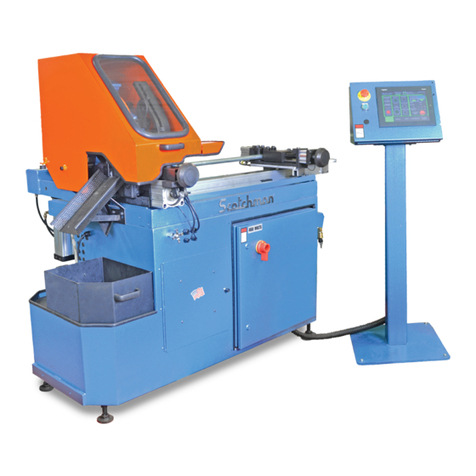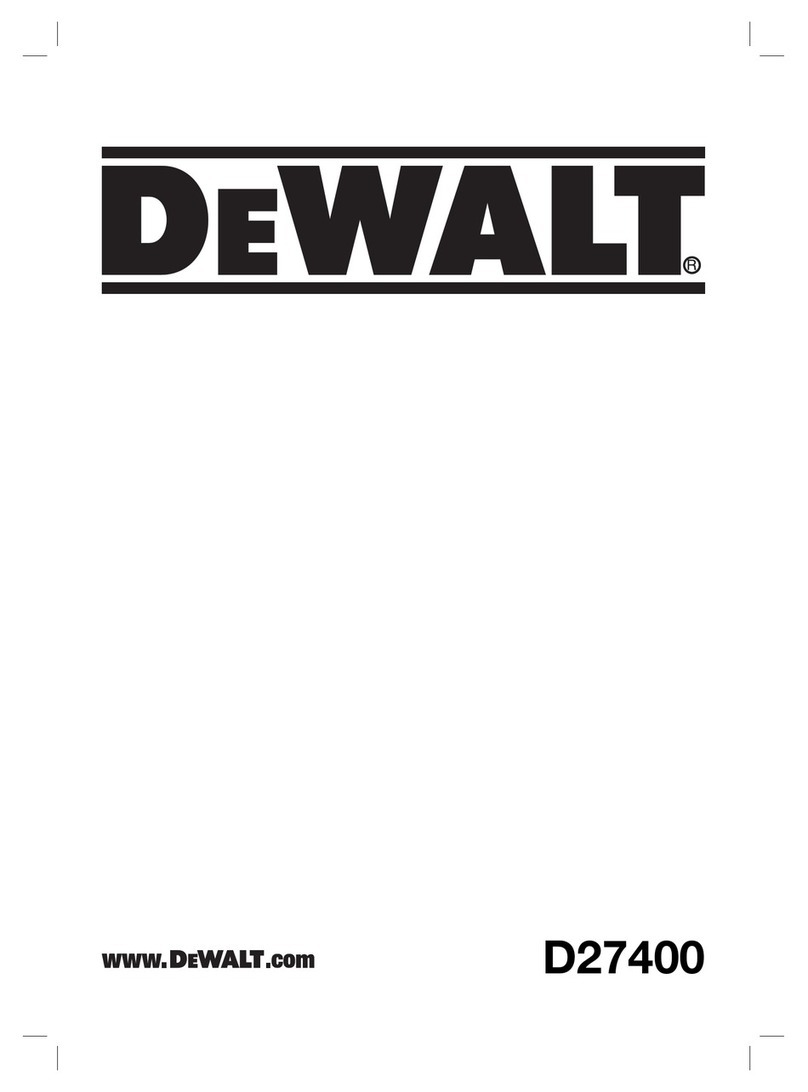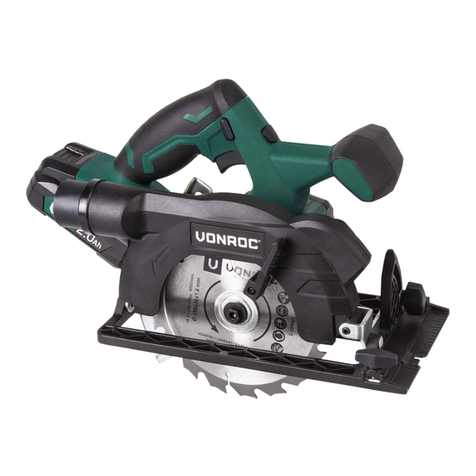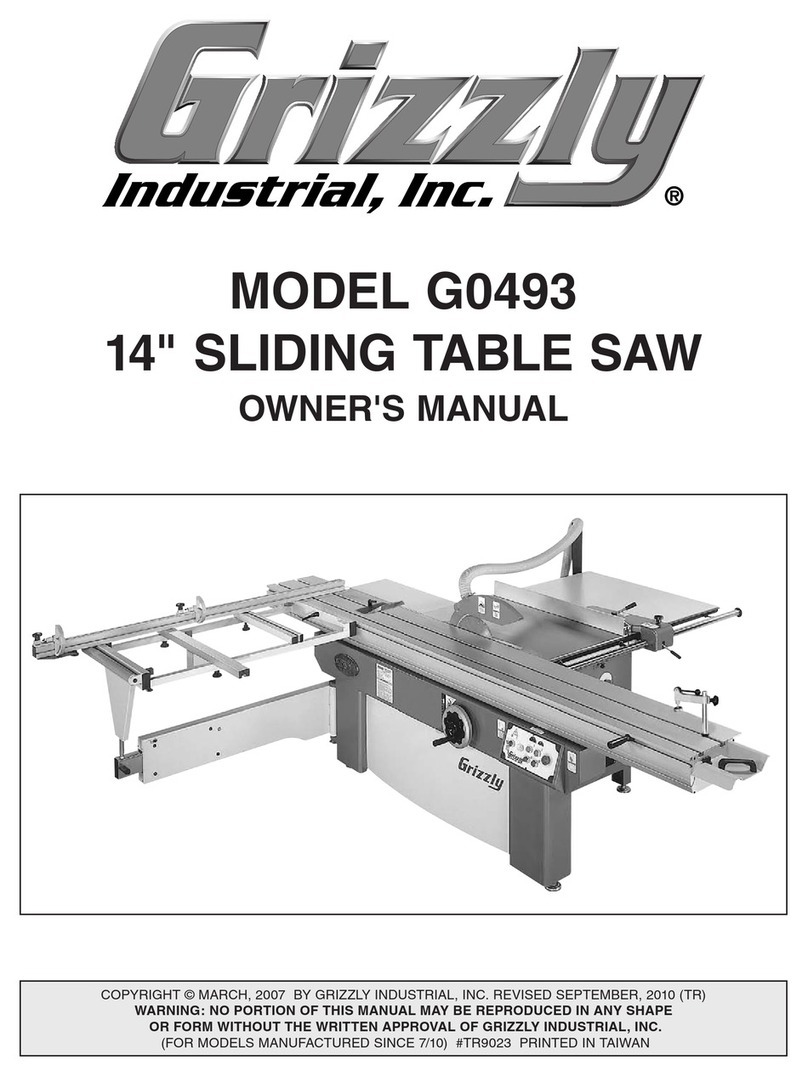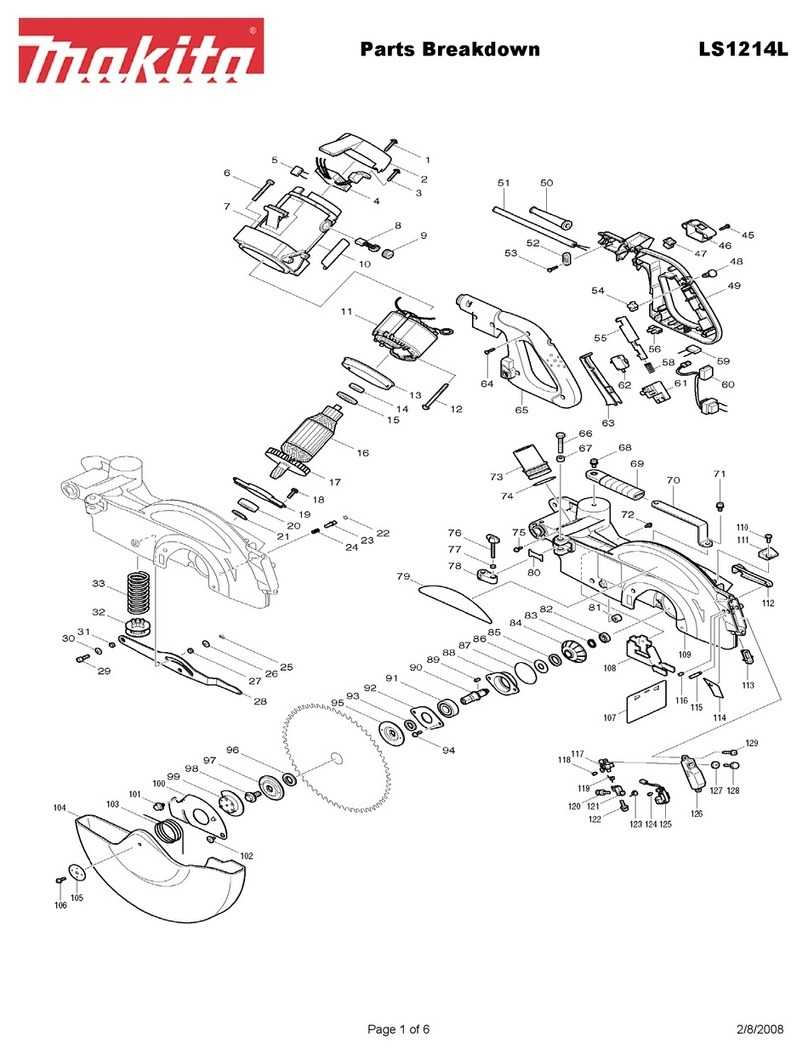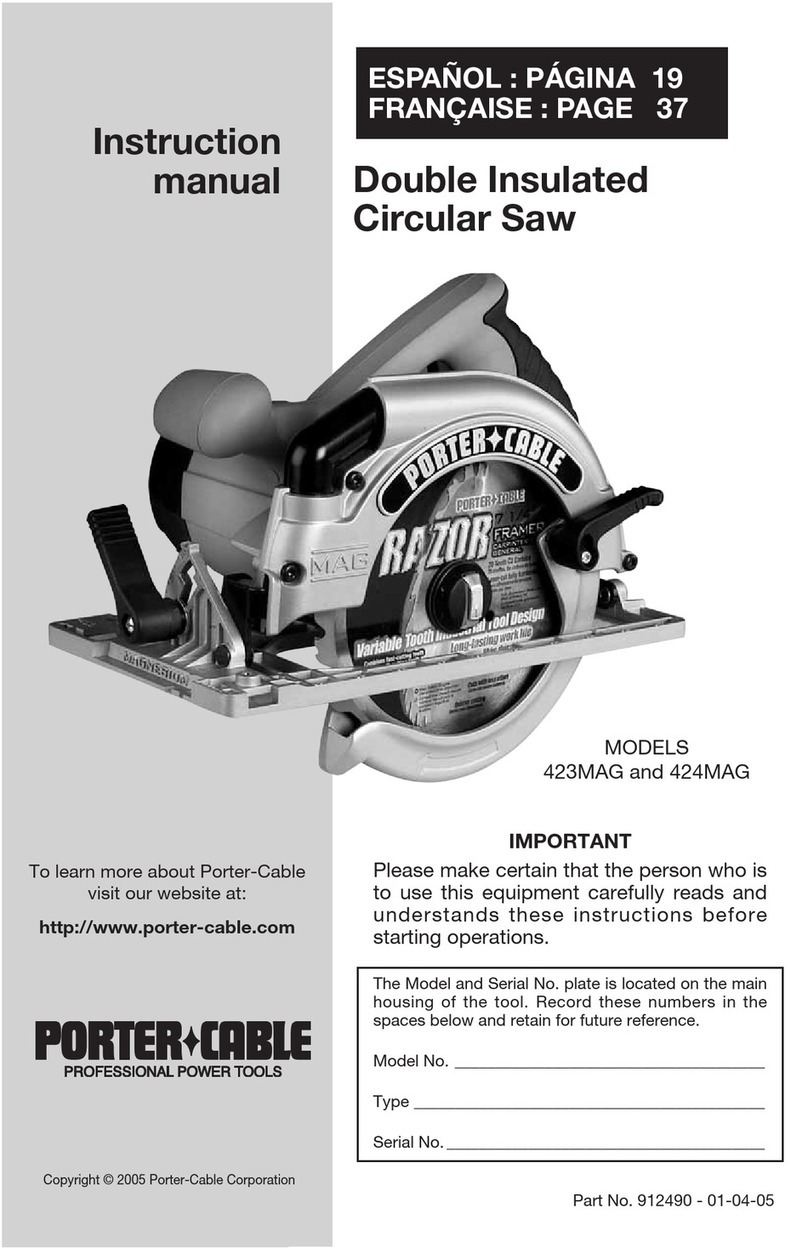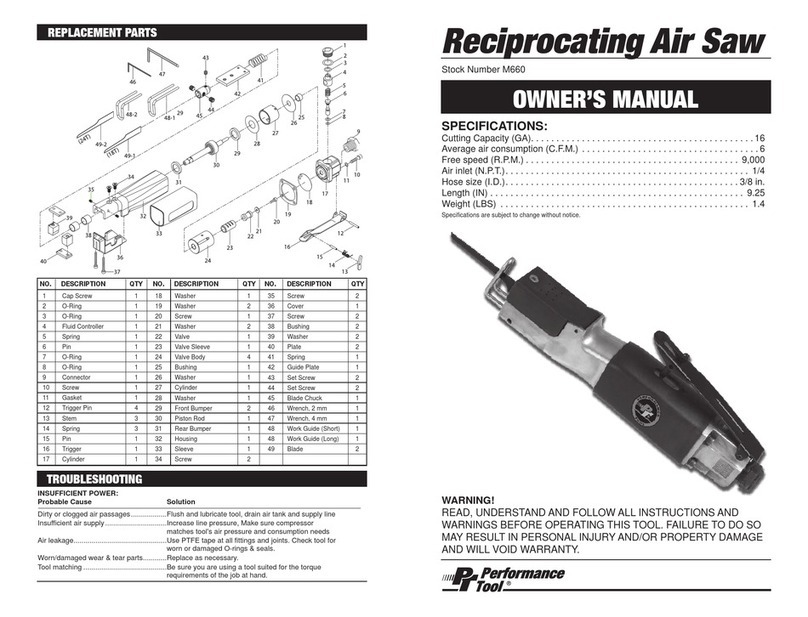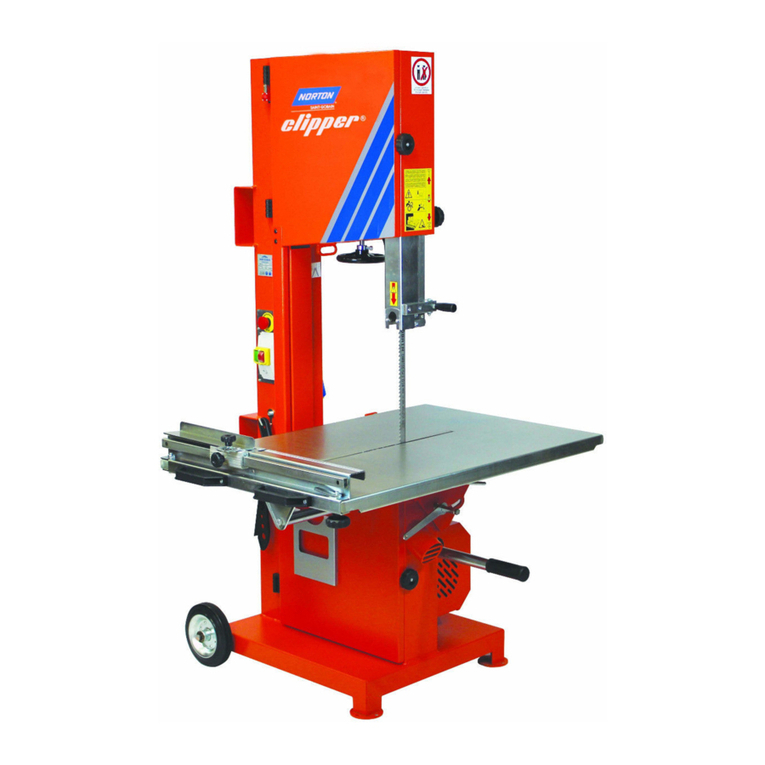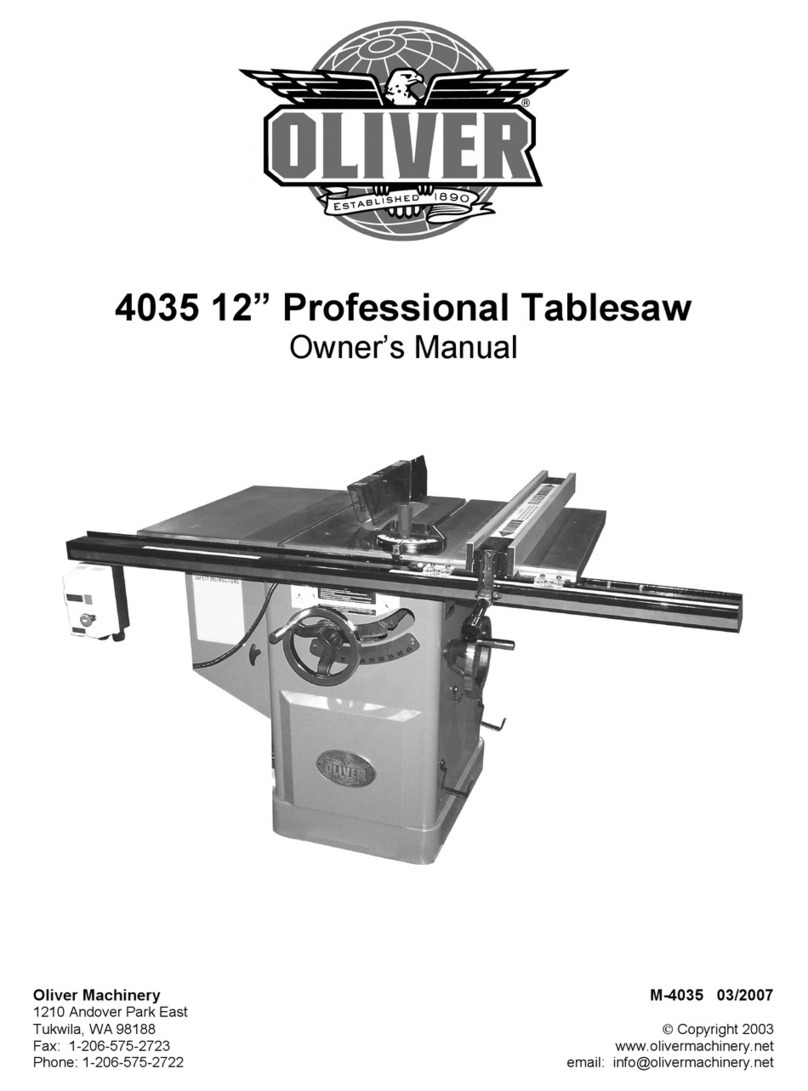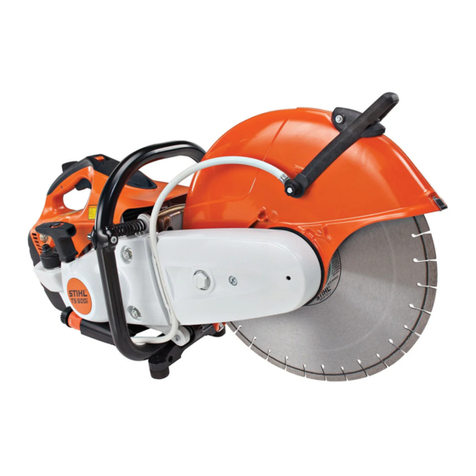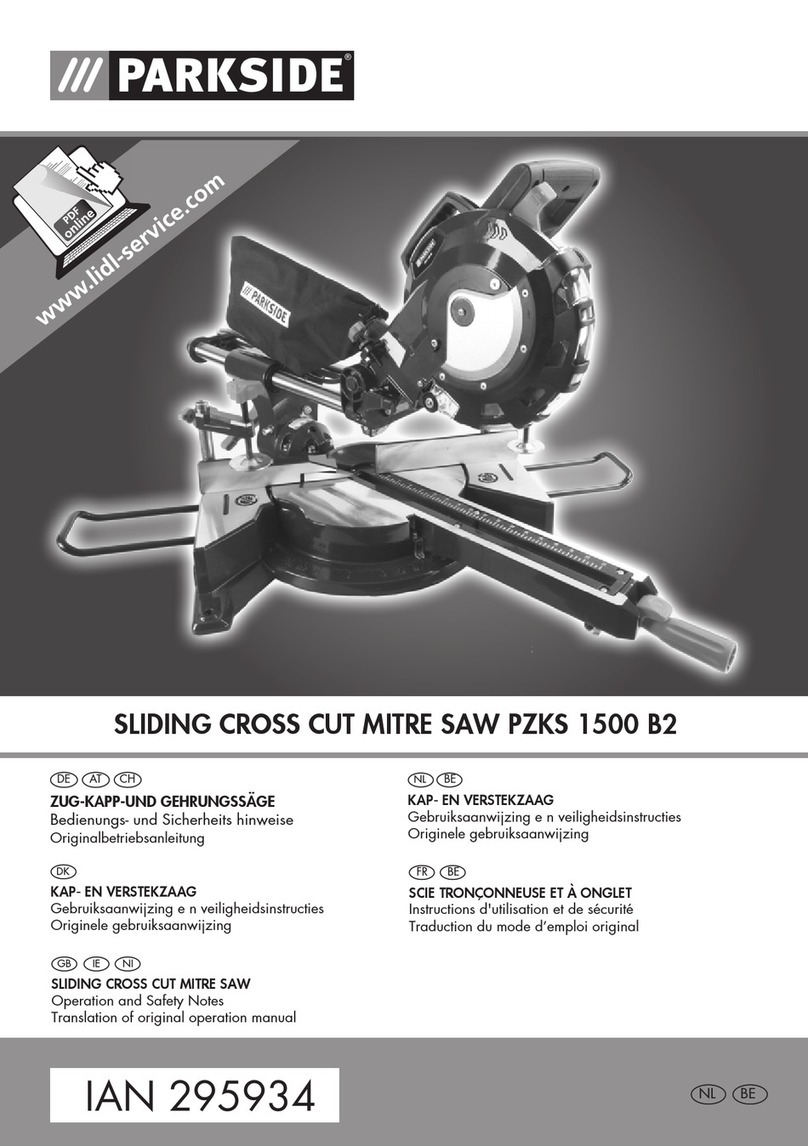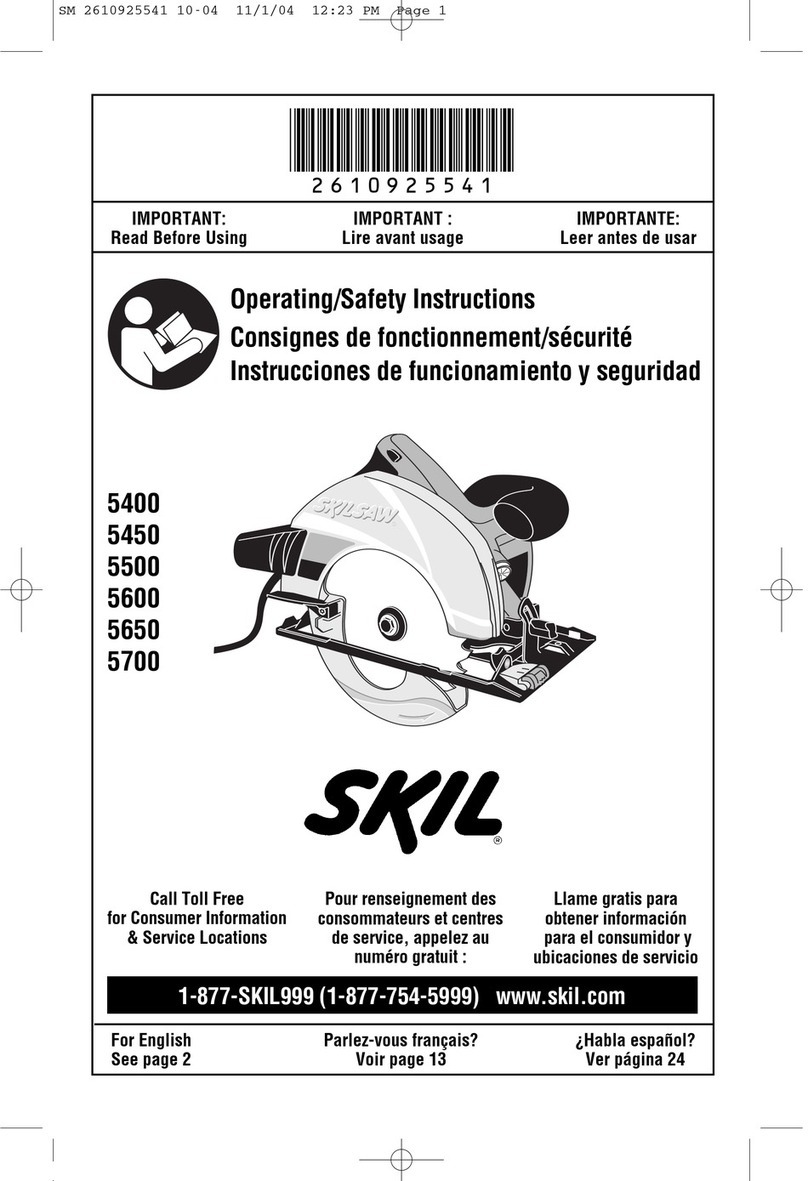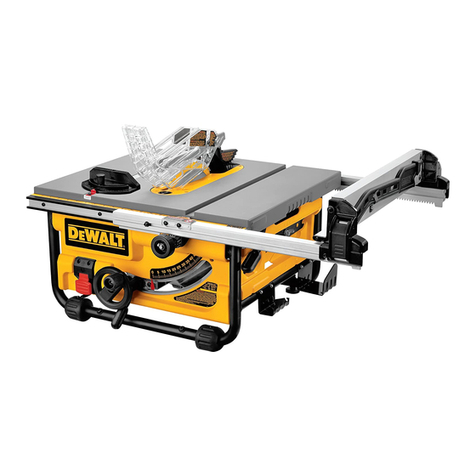Scotchman CPO-275 User manual

You have downloaded a manual for our
MODEL CPO-275 COLD SAW
Please download our .pdf
"Cold Saw Blade Basics" too.
Please read both the manual & the "Cold Saw
Blade Basics" before operating this saw!!
CPO-275
COLD SAW

www.scotchman.com
MODEL
CPO-275
COLD SAW
AUGUST 2023
S/N B39330422 & AFTER
SCOTCHMAN IND. - 180 E US HWY 14 - PO BOX 850 - PHILIP, SD 57567 Call: 1-605-859-2542

Page 2
TABLE OF CONTENTS
1.0 INTRODUCTION 4
2.0 SAFETY PRECAUTIONS 4
3.0 WARRANTY 5
4.0 INSTALLATION & SET-UP 6
4.1 Physical Dimensions 6
4.2 Machine Moving Procedures 8
4.3 Physical Inspection 10
4.4 Electrical Requirements 11
4.5 Machine Start-up 16
4.6 FRL Use and Maintenance 17
4.7 19
5.0 MAINTENANCE & LUBRICATION 20
5.1 Lubrication 20
5.2 Cutting Oils & Lubricants 21
5.3 Scheduled Maintenance 21
5.4 Coolant Pump Maintenance 22
6.0 MACHINE OPERATION
6.1 Installing The Blade - Manual Machines
6.2 Saw Capacities
6.3 Selecting The Proper Blade & Cutting Speed 27
6.4 Material Clamping
26
6.5 Miter Locking Device 30
7.0 OPTIONAL EQUIPMENT
7.1 Power Vise
Power Vise Set-up & Maintenance
7.3 Replacing the Spindle in the Power Vise
7.4 Replacing the Seals in the Power Vise
7.5 Power Down Feed
34
7.6 Power Down Feed Set-up & Maintenance
35
7.7 Stroke Control Adjustment (Power Down Feed)
36
7.8 Guard Adjustment (Power Down Feed)
38
7.9 Installing Blades (Power Down Feed)
40
42
SCOTCHMAN IND. - 180 E US HWY 14 - PO BOX 850 - PHILIP, SD 57567 Call: 1-605-859-2542
4.8 Coolant System
Guard Adjustment
20
24
24
28
7.2 32
32
32
36
SECTION DESCRIPTION PAGE

SECTION
7.13
7.14
7.15
8.0
8.1
8.2
8.3
8.4
9.0
9.1
9.2
9.3
9.4
9.5
9.6
9.7
9.8
10.0
10.1
10.2
DESCRIPTION
Special Vise Jaws
Lock-Out Disconnect Switch
Pneumatic Diagram for PK PD Machines
TROUBLE SHOOTING GUIDE
Electrical Trouble Shooting
Breakage or Excessive Dulling of Blades
Coolant System
Gear Replacement
PARTS LISTS
Saw Head
Vise Assembly
Guard Assembly
Motor Assembly
Electrical Unit (After June 1996)
Coolant Pump
Cast Base and Pedestal
OPTIONAL EQUIPMENT PARTS LISTS
Power Vise Assembly
Power Down Feed Assembly
Power Down Feed Electric Controls - S/N B31071003 & UP
10 Foot (303 CM) Supply Track
10.3
10.4
10.5
10.6
10.7
11.0
Overview of Scotchman Measuring Systems
Cutting Coolants & Lubricants
STOCK BLADES
PAGE
50
55
56
58
60
62
64
66
68
72
74
76
78
80
82
84
86
88
Material Stop 30 Inch (76 CM)
Page 3
Power Down & Power Vise Trouble Shooting
7.11 Material Supply Tracks
44
TABLE OF CONTENTS
46
7.12 Scotchman Measuring Systems 48
50
50
52
52
53
54
Saw Base Cabinet
56
70
Power Down Feed Controls - S/N B31071003 & UP
10.8
10.9
72
86
SCOTCHMAN IND. - 180 E US HWY 14 - PO BOX 850 - PHILIP, SD 57567 Call: 1-605-859-2542
7.10
Guard Assembly (Power Down Feed)

SCOTCHMAN INDS. - 180 E. HWY 14 - PO BOX 850 - PHILIP, SD 57567 PHONE: 1-800-843-8844
Page 4
1.0 INTRODUCTION
The CPO-275 Cold Saw is designed to cut solids, tubes, flats and other profiles in grades of material
that range from hot and cold rolled steel, annealed tool steels, stainless, aluminum, brass, copper,
synthetics and extrusions.
Cold sawing is a process similar to a milling process. In most cases, this, combined with the self
centering vise feature, gives a finished cut that does not require any secondary machining or de-burring.
Since milling spindle speeds are used in cold sawing, there are several things that are required to
achieve quality results. The selection of the proper pitch (number of teeth) on the blade and the proper
spindle speed for the type of material being cut are critical. Proper material clamping and a good
quality coolant are also important.
Cold sawing has several advantages over band saws and abrasive saws. Besides the mill quality cut, cold
saws have the ability to generate faster cutoff times than band saws.
There are no sparks and excessive noises that are associated with abrasive cutoff saws.
Cold saws also offer the advantage of blades that can be re-sharpened until the diameter of the blade
will no longer cut through the material. The self centering vise allows for easy changeover to special
clamping jaws, for profiles and extrusions. Having two spindle speeds enables the user to cut a wide
range of materials.
By adding the power vise and power down feed options, the saw can be converted to a semi-automatic
machine at a very reasonable price.
2.0 SAFETY PRECAUTIONS
1. Any individual operating this machine must be qualified, responsible and well instructed. This
manual is not intended to teach untrained personnel how to operate equipment.
2. NEVER operate this machine with the guard disconnected or removed.
3. Wear eye protection, at all times, when operating or observing this machine in operation.
4. Do not wear loose fitting clothing, gloves or jewelry when operating this machine.
5. All electrical connections shall be made by a qualified electrician. This machine must be grounded
in accordance with the National Electric Code.

Page 5
7. Practice good housekeeping. Keep the area around the machine clean and dry.
8. When sawing, always support long pieces and make sure that the material is properly clamped.
9. Keep the guard, as well as all other parts of the saw, in good working condition. Replace worn
parts promptly.
10. Do not alter or modify this machine in any way without written permission from the
manufacturer.
11. This machine is top heavy and must be anchored to the floor via the holes in the saw base.
3.0 WARRANTY
Scotchman Industries, Inc. will, within three years of the date of purchase, replace F.O.B. the factory or
refund the purchase price for any goods which are defective in materials or workmanship, provided the
buyer, at the seller’s option, returns the defective goods freight and delivery prepaid to the seller, which
shall be the buyer’s sole and exclusive remedy for defective goods.
This warranty does not apply to machines and/or components which have been altered, changed or
modified in any way or subjected to abuse and abnormal use, inadequate maintenance and lubrication
or subjected to use beyond the seller’s recommended capacities and specifications.
In no event shall the seller be liable for labor cost expended on such goods or consequential damages.
The seller shall not be liable to the purchaser or any other person for loss or damage directly or
indirectly arising from the use of the goods or from any other cause.
No officer, employee or agent of the seller is authorized to make any oral representations or warranty
of fitness or to waive any of the foregoing terms of sale and none shall be binding on the seller.
Any electrical changes made to the standard machine due to local electrical code variation must be paid
by purchaser.
As we constantly strive to improve our products, we reserve the right to make changes without notification.
This warranty is effective December 1, 2009.
6. Disconnect the machine from the power source before performing maintenance or changing
blades.

Page 6
4.0 INSTALLATION AND SET-UP
4.1 PHYSICAL DIMENSIONS
SEE FIGURE 1 ON THE FOLLOWING PAGE.
DIMENSIONS INCHES CM
A. HEIGHT 68.5 175
B. FLOOR TO VISE 36.4 92.4
C. BASE HEIGHT 32 81
D. VISE OPENING 410
E. VISE DEPTH 25
F. BASE WIDTH 21.5 55
G. BASE DEPTH 17.25 44
H. MOUNTING HOLE CENTERS 24.5 62
I. WIDTH 26.2 66
J. WEIGHT 550 LB. 249 KG.
CAUTION: THIS SECTION DISCUSSES INSTALLATION, SET-UP AND START-UP
PROCEDURES. PLEASE READ IT THOROUGHLY BEFORE OPERATING
THIS MACHINE. IF YOUR MACHINE IS EQUIPPED WITH EITHER THE
POWER VISE OR THE POWER DOWN FEED OPTION, READ ALL SECTIONS
CONCERNING THESE OPTIONS BEFORE OPERATING THE SAW.

Page 7
FIGURE 1
A
BC
F
G
HI
E
D

Page 8
4.2 MACHINE MOVING PROCEDURES
SEE FIGURE 2 ON THE FOLLOWING PAGE.
This machine is shipped on a pallet and can be moved to the installation location by means of a fork lift.
CAUTION : THIS MACHINE IS TOP HEAVY AND MUST BE MOVED WITH CARE, ON
HARD, FLAT SURFACES ONLY.
All saws are shipped with the head locked in the DOWN position. Before lifting the machine, release the
head on manual and power vise saws by cutting the banding strap and allowing it to move to the UP
position. On machines equipped with the power down feed option, release the upper stroke control collar
and allow the head to move to the UP position. Lift the machine, using the lifting eyelet provided.
Remove the pallet and place the machine in its final location. This machine is top heavy and must be
anchored to the floor via the holes provided in the saw base.

Page 9
FIGURE 2
LIFTING EYE
LIFTING FORKS

Page 10
4.3 PHYSICAL INSPECTION
CAUTION: DO NOT USE THE LIFTING EYELET FOR ANY MACHINES OTHER THAN
THIS SAW. MAKE SURE THAT THE DRAW HANDLE HAS A JAM NUT ON
THE THREADS BEFORE INSTALLING IT ON THE SAW. IF THE HANDLE IS
INSTALLED WITHOUT THE JAM NUT, IT MAY CONTACT THE GEARS
INSIDE THE HEAD.
Once the machine is located, check it for any possible damage incurred in shipment. Remove the lifting
eyelet and install the draw handle.
After the draw handle has been installed on manual and power vice machines, remove the cover from the
electrical control box and connect the trigger switch wires. REFER TO FIGURES 3-1 thru 3-4.
Remove any other packing material and draw the saw head to its DOWN position to make sure that the
guard opens properly. The guard should close completely when the head is up and open freely as the
head travels down.
If the guard is not functioning properly, REFER TO SECTION 4.7 FOR THE MANUAL MACHINES
OR SECTION 7.8 FOR MACHINES EQUIPPED WITH THE POWER DOWN FEED OPTION.
With the head in the UP position, check the oil level in the gear box through the sight glass in the
casting just below the draw handle.
If your saw is equipped with either the power vise or the power down feed option, REFER TO
SECTION 7.0 for additional information.

Page 11
4.4 ELECTRICAL REQUIREMENTS
SEE FIGURES 3-1 THRU 3-4 ON THE FOLLOWING PAGES.
CAUTION: TO PREVENT DAMAGE TO THE MACHINE AND DANGER TO THE
OPERATOR, ALL ELECTRICAL CONNECTIONS MUST BE MADE BY A
QUALIFIED ELECTRICIAN. THIS MACHINE OPERATES WITH LIQUID
COOLANT AND MUST BE GROUNDED IN ACCORDANCE WITH NATIONAL
All three phase motors are dual speed and will operate on one voltage only. Single phase motors are
available in the 60 RPM speed, only. If the machine is not the same voltage as your plant voltage, you
will have to replace the motor and rewire the transformer and coolant pump. To insure satisfactory
performance, the supply voltage should be (+ or -) 10% of the motor voltage rating. Check the motor
data tag for full load current requirements.
THE ELECTRICAL DIAGRAMS FOR THIS MACHINE ARE ON PAGES 12 THRU 15, FIGURES 3-1
THRU 3-4. For supply lines ten feet (303 cm) or shorter, we recommend 12 gauge wire. For lines longer
than ten (303 cm), we recommend 10 gauge wire. We do not recommend supply lines over twenty feet
(606cm) in length.
CPO-275-LT. (30-60 RPM)
MOTOR VOLTAGE FULL LOAD CURRENT HORSEPOWER
HI LOW HI LOW
208 4.9 4.7 1.5 .75
230 4.7 4.5 1.5 .75
460 2.6 2.5 1.5 .75
230 1/Phase 9.4 1.5
CPO-275-HT. (60-120 RPM)
MOTOR VOLTAGE FULL LOAD CURRENT HORSEPOWER
HI LOW HI LOW
208 7.9 5.7 21.6
230 7.7 5.5 21.6
460 42.9 21.6
230 1/phase 9.4 1.5
ELECTRIC CODES.
► NOTE: SEE SECTION 7.10 FOR THE WIRING SCHEMATIC FOR THE CURRENT
ELECTRIC POWER DOWN-FEED SYSTEM.

MANUAL OR PK W/ TRIGGER SWITCH
FIGURE 3-1
Page 12
A
E
D
B
C
A. Relay
B. Main Switch
C. Saw Motor
D. Coolant Pump
E. Ground
MOTOR
DISCONNECT
SUPPLIED BY CUSTOMER
TRIGGER SWITCH
TRANSFORMER
R
1FU
XF
FUSE
X2
H4
H2
H3
H1
2 2
51
L1
L2
L3
GRD
RED
WHT
BLK
GRN
BLK
WHT
RED
M
5
6
2W
1W
1V
2V
2U
1U
A1 1 3 5 13 A2
A2
14
62 4
3 117 15 19 23
1 5 9 13 17 21
8 12 16 20 24
4
6 10 14 18 22
2
L1
L2
L3
X1

PKPD W/EMERGENCY STOP
FIGURE 3-2
Page 13
A
B
D
E
C
3 117 15 19 23
1 5 9 13 17 21
8 12 16 20 24
4
6 10 14 18 22
2
GRN
BLK
WHT
RED
M
A. Relay
B. Main Switch
C. Saw Motor
D. Coolant Pump
E. Ground
DISCONNECT
SUPPLIED BY CUSTOMER
L1
L2
L3
F
TRANSFORMER
1FU
XF
FUSE
X2
H4
H2
H3
H1
X1
2 2
51
MOTOR
5
6
2W
1W
1V
2V
2U
1U
R
RED
WHT
BLK
230V
EMER. STOP
L1
L2
L3
GRD
LOWER LIMIT SW.
N.C.
BLACK RED
BLACKWHITE
UPPER LIMIT SW.
N.O.
WHITE RED
FOOT PEDAL SWITCH
N.O.
GRD
WHITE
BLACK HEAD
BLACK
VISE
RED
BLUE
P/N 45655
CYL. VALVE
P/N 45655
CYL. VALVE
BLACK
INCOMING POWER
JUMPER
44342214
43332113
A2
A1
NONONCNO
NONONCNO
DIL A-31
24V RELAY
RELAY
(SEE SECTION 7.10 FOR POWER DOWN FEED WIRING DIAGRAM)

1-PHASE MOTOR W/TRIGGER SWITCH
FIGURE 3-3
Page 14
A. Relay
B. Saw Motor
C. Coolant Pump
D. Ground
A
D
B
C
MOTOR
DISCONNECT
SUPPLIED BY CUSTOMER
BRN BLU
CAPACITOR
GRN
BLK
WHT
M
SINGLE PHASE PUMP
2 2
51
TRIGGER SWITCH
TRANSFORMER
1FU
XF
FUSE
X2
H4
H2
H3
H1
X1
R
RELAY
WHT
BLK
A1 1 3 5 13 A2
A2
142 4 6
L2
L3
GRD
INCOMING POWER
L2
L3
1Z
2Z
2U
1U

1-PHASE MOTOR W/E-STOP
SERIAL #'S B3431 & UP
FIGURE 3-4
Page 15
CYL. VALVE
P/N 45655
CYL. VALVE
P/N 45655
BLACK
BLACK
WHITE
BLACKWHITE
UPPER LIMIT SW.
N.O.
LOWER LIMIT SW.
N.C.
BLACK RED
JUMPER
FUSE
FUSE
FUSE
WHITE RED
FOOT PEDAL SWITCH
N.O.
GRD
L2
L3
GRD
INCOMING POWER
EMER. STOP 2 2
51
TRANSFORMER
1FU
XF
FUSE
X2
H4
H2
H3
H1
X1
RELAY
44342214
43332113
A2
A1
NONONCNO
NONONCNO
DIL-ER-31-G
24V RELAY
A. Relay
B. Main Switch
C. Saw Motor
D. Coolant Pump
E. Ground
RED
BLUE
A
D
E
B
C
WHT
BLK
A1 1 3 5 13 A2
A2
142 4 6
GRN
BLK
WHT
M
SINGLE PHASE PUMP
1 3
2 4 SWITCH
BRN BLU
CAPACITOR
DISCONNECT
SUPPLIED BY CUSTOMER
MOTOR
H
5
6
1Z
2Z
2U
1U
L2
L3
BLACK
R

Page 16
4.5 MACHINE START-UP
Before starting this machine, take the time to review the operator’s manual thoroughly, to familiarize
yourself with all of the functions of the machine.
We strongly urge you to follow OSHA directive CFR-1910.147 (effective 09-09-90) regarding lock-out,
tag-out procedures. Keep in mind that the directive refers to all hazardous energy sources, not just
electrical.
On machines equipped with either a power vise or a power down feed, the air supply must also be
disconnected and locked or tagged.
Scotchman offers a lock-out switch for this machine as an option, if your plant is not equipped with
lock-out capabilities. If you are interested in this option, REFER TO SECTION 7.14 or contact your
local dealer or the factory.
Do not install a blade on the saw until after it has been powered and cycled several times.
To power manual and power vise machines, turn the HIGH/LOW switch to either the HIGH or the LOW
POSITION and use the trigger switch mounted in the draw handle to start the motor. Always turn the
HIGH/LOW switch to the OFF position when the saw is not in use.
To power machines equipped with the power down feed option, turn the HIGH/LOW switch to either the
HIGH or the LOW position and depress the foot switch to start the motor. The foot switch can be used to
cycle the saw head without starting the motor, by leaving the HIGH/LOW switch in the OFF position.
We do not recommend using the emergency stop switch to turn the machine off during normal operation.
If the emergency stop switch is used, it must be manually reset by pulling the switch back out.
Always turn the HIGH/LOW switch to the OFF position when the saw is not in use.
Once the machine has been powered, check the rotation of the spindle. There is an arrow on the guard
showing the proper rotation. If the rotation is not correct, the electrician will have to switch two of the
three line wires.
If the saw is equipped with either the power vise or the power down feed options:
GO TO SECTION 7 - OPTIONAL EQUIPMENT
There you will find additional information and instructions on the options available for this saw.

Page 17
4.6 FRL USE AND MAINTENANCE
The FRL (Filter Regulator Lubricator) is an important and often overlooked item on a cold saw. It helps to
keep moisture from contaminating the pneumatic system and adds a little oil to keep the system lubricated.
REGULATOR
The regulator has the gauge and air pressure is adjusted the knob on top. Pull the knob up to adjust the air
pressure and push it down to lock it in place. We recommend 90 psi to 105 psi to operate this saw.
WATER TRAP
Another important function with the regulator is that it has a water trap that is attached to the bottom of the
regulator. It should be checked everyday. If the trap is a over half full, it should be removed and emptied. The
drawing on the next page has detailed instructions on how to do this. Take care to not damage the o-rings.
OILER
The oiler should add a drop of oil to the pneumatic system every 5 -10 cycles. This can be seen at the top of
the oiler. You can see a small tube that the oil drips from. If the oiler needs adjustment, there is a small screw
located on the top of the oiler that can be adjusted with a small straight screwdriver.
OILER RESERVOIR
The reservoir for the oiler is attached to the bottom of the oiler. The oil level in the oiler should be checked
every day. When the level gets low, the reservoir should be removed and filled about 3/4 full with a quality
(ISO 22) air line lubricant designed for automatic oilers (such as our P/N 075759) and installed back on the
lubricator. The drawing on the next page has detailed instructions on how to do this. Take care to not damage
the o-ring.
SEE FIGURE 4 ON THE NEXT PAGE
CAUTION: SHUT OFF AIR SUPPLY BEFORE SERVICING THE FRL

Page 18
FIGURE 4
CAMOZZI FRL (Filter/Regulator/Lubricator)
IN OUT
OILER ADJUSTMENT HERE
Use a small straight screwdriver
to Increase or Decrease the
amount of oil used.
AIR PRESSURE
ADJUSTMENT HERE
Pull up knob to adjust pressure
Push down to lock in place
DETAIL
TO ADD OIL TO OILER
Remove oil reservoir by pressing
in the tab on the clear plastic
part at the bottom and turning it
counter-clockwise till it stops.
Then pull reservoir free from
the oiler. Fill reservoir with oil a
1/2"-3/4" from the top and
reattach in reverse order.
- See "DETAIL" below -
Oil Reservoir
O-Ring
TAB
DETAIL
TO CHECK REGULATOR
WATER-TRAP FILTER
Remove the water trap by pressing
in the tab on the clear plastic part
at the bottom and turning it
counter-clockwise until it stops.
Then pull water trap free. Filter
can be removed by squeezing the
tabs on top together, to allow for
cleaning. When done, snap filter
back into place and reattach in
reverse order.
- See "DETAIL" below -
Water
Trap
Assy.
Filter
Assy.
(2)
Tabs
O-Ring
Water Trap
usually more
difficult to
remove
Seal
Shuttle
Valve
DISCONNECT AIR SUPPLY!!
Scotchman Air Line
Lubricant is recommended
Qt. 075753 - Gal. 075759
PUSH TO OPEN
Depress Tab
& Turn CC
PUSH TO OPEN
Depress Tab
& Turn CC
A
I
R
P
R
E
S
S
U
R
E
G
A
U
G
E
PUSH TO OPENPUSH TO OPEN
O-Ring

Page 19
4.7 GUARD ADJUSTMENT
SEE FIGURE 5 BELOW.
FOR GUARD ADJUSTMENT PROCEDURES ON SAWS EQUIPPED WITH THE POWER DOWN
FEED OPTION, REFER TO SECTION 7.8.
The proper adjustment of the blade guard on this machine is crucial to the operation of the machine and
the safety of the operator. If the guard will not maintain proper adjustment, check the guard mounting
bolts and rivet joints in the guard and linkage, for wear. Replace worn parts promptly.
USE THE FOLLOWING STEPS TO ADJUST THE BLADE GUARD:
1. Turn the power OFF and disconnect from the power source.
2. With the head in the UP position, loosen the jam nut (G) on the guard cam (F).
3. Manually hold the guard open approximately 1/8 of an inch (3mm) at point (H).
4. Rotate the guard cam (F) counterclockwise until there is tension on the linkage bar. Re-tighten the
jam nut (G).
5. Manually cycle the head up and down several times, making sure that the guard operates
properly.
FIGURE 5
F
A
G
H
Other manuals for CPO-275
1
This manual suits for next models
1
Table of contents
Other Scotchman Saw manuals
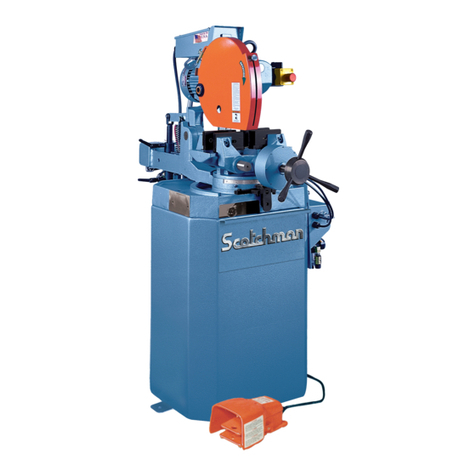
Scotchman
Scotchman CPO 350 User manual

Scotchman
Scotchman CPO-275 User manual
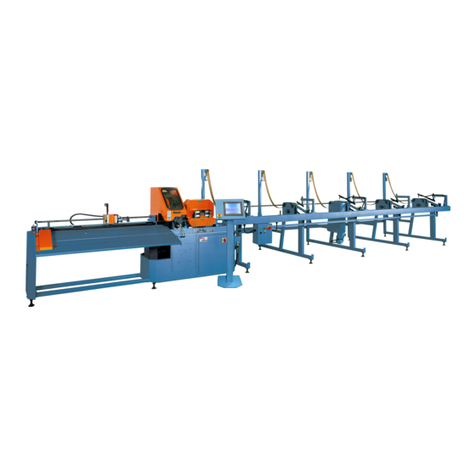
Scotchman
Scotchman CPO-315-RFA-NF User manual

Scotchman
Scotchman CPO-315-HFA-5HP User manual

Scotchman
Scotchman CPO-350-NF-5HP User manual

Scotchman
Scotchman GAA-500-90 NF User manual
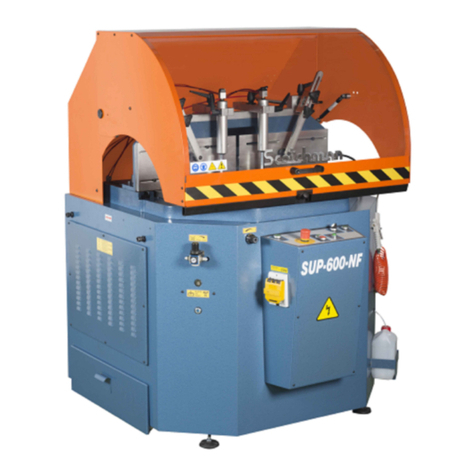
Scotchman
Scotchman SUP-600-NF User manual
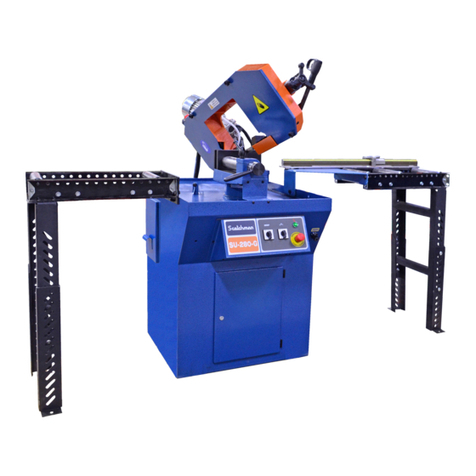
Scotchman
Scotchman SU-280-G User manual

Scotchman
Scotchman SU-280 User manual
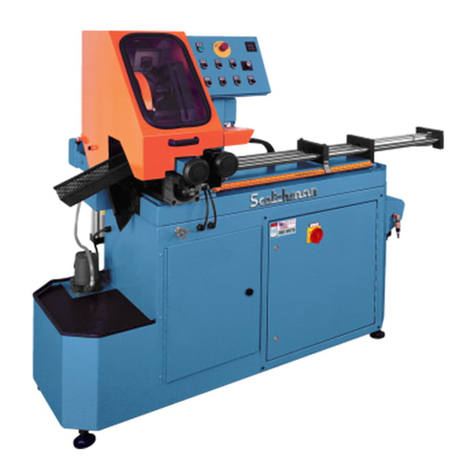
Scotchman
Scotchman CPO-315-HFA-NF User manual
